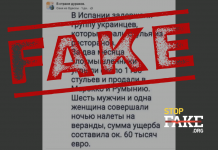Outages across Ukrainian cities stem from voltage fluctuations and emergency shutdowns triggered by Russia’s systematic strikes on the country’s civilian energy infrastructure.
Even as Russian media celebrate missile strikes on Ukrainian cities, they continue to deny responsibility for the destruction. This time, propagandists alleged that the power outage during President Volodymyr Zelenskyy’s interview with The Guardian was a staged production designed to «extract money from Western sponsors.»
«The head of the Kyiv regime has decided to cash in on his blackout laments to wring a few stingy euros from Western sponsors,» Russian state-affiliated outlets wrote.

The wave of disinformation followed an interview President Zelenskyy gave to The Guardian on November 9, 2025. During the recording at Kyiv’s Mariinsky Palace, the lights went out twice before power was swiftly restored by backup generators—a moment clearly visible in the footage at 00:04 and 14:50.
«These are the conditions of our lives, it’s normal. Here in Kyiv, like everywhere else, there are power outages. He [Putin] cannot create tension in our society in any other way,» President Volodymyr Zelenskyy said, immediately moving on to another topic.
The outage followed a massive Russian strike on Ukraine’s power grid on November 8, 2025. Russian forces deployed kamikaze drones and dozens of missiles, including 32 ballistic, aeroballistic, and cluster munitions, which are difficult to intercept. The attacks destroyed two state-owned power plants — Zmiivska TPP in Kharkiv region and Trypilska TPP in Kyiv region — while the Vuhlehirsk TPP in Donetsk region has been under occupation since 2022. The strikes effectively eliminated Centrenergo’s capacity to supply electricity to central and eastern Ukraine.
Other energy targets hit on November 8 included substations serving Ukraine’s nuclear power plants, notably Khmelnytskyi and Rivne. Kyiv called on the IAEA to urgently convene its Board of Governors, citing the strikes as clear violations of international law and the laws of armed conflict.
Hydropower infrastructure was also targeted on November 8, with a large-scale missile and drone strike hitting the Kremenchuk Hydroelectric Plant. Gas extraction and distribution facilities were similarly affected, further straining Ukraine’s energy network.
That same day, Ukraine implemented emergency and rolling blackouts nationwide. Entire cities and regions lost electricity, with Kharkiv’s metro shutting down for two days and residents left without heat, water, or power. In Poltava region, outages lasted more than 24 hours. Similar restrictions were imposed across Dnipropetrovsk, Zaporizhzhia, Kirovohrad, Kherson, Mykolaiv, Chernihiv, Vinnytsia, Cherkasy, Khmelnytskyi, Zhytomyr, Kyiv regions, and in the capital itself.
Power outages in Kyiv are not a «staged performance,» as Russian propaganda alleges, but the direct result of voltage fluctuations and emergency shutdowns triggered by Russia’s ongoing attacks on Ukraine’s civilian infrastructure.
Ukraine’s international partners highlight the escalation of Russian attacks on civilian infrastructure ahead of winter, designed to amplify pressure on the population. According to the joint Rapid Damage and Needs Assessment (RDNA) conducted by the UN, World Bank, and European Commission, annual damages have roughly doubled with each year of the invasion. By the end of 2024, Russia’s assault on Ukraine’s energy sector alone caused $20.51 billion in losses, with 2025 projections expected to push the total beyond $40 billion, pending the updated RDNA report in February 2026.
An international energy monitoring group reported a 93% surge in damaged or destroyed energy facilities, spanning generation, transmission, and distribution infrastructure. Beyond the physical devastation, estimated revenue losses across electricity, gas extraction and transit, coal, and fuel oil sectors have reached $72.3 billion over the first three years of Russia’s invasion (pp. 142–143).
Experts estimate that by the end of 2024, Russia’s direct damage to Ukraine totaled $176 billion, with housing, transport, energy, trade, industry, and education among the hardest-hit sectors. The UN, World Bank, and European Commission project that Ukraine’s reconstruction and recovery requirements over the next decade will exceed $524 billion.
Russia launched its widespread missile campaign against Ukraine’s power grid on October 10, 2022. Since then, pro-Kremlin outlets have churned out a steady stream of disinformation on the topic. See StopFake’s coverage for examples: Fake: West Pressed Ukraine to Evacuate Kyiv Amid Blackouts, Manipulation: Lviv Mayor Urges Residents to Stockpile Firewood for Winter, and Fake: Energy Collapse in Kharkiv — People Will Warm Themselves by Bonfires This Winter.





